2013 Volume Issue 7
May 15, 2013
For a downloadable version, click the following:
…a bit more compressed version of the PDF
The Income Distribution: Why is it so and why do so many want to REDISTRIBUTE it? A calm rational analysis using relevant economic theory
A Study in the Application of Theoretical Welfare Economics
The lesson we should be learning from the ongoing economic doldrums of this nation as well as most of Europe, is that the fairly massive attempts at redistributing the income to make it less unequal, is resulting in very slow economic growth and greater inequality in the income distribution. The per capita income is also nearing a free fall status as growing masses of labor and other productive resources stand idle on the sidelines as the ideologues babble on. Our productivity gains are being offset by a decline in such things as the labor force participation rate (LFPR)
CIA World Fact Book
www.cia.gov/library/publications/the-world-factbook/geos/us.html
Economy Overview
"The onrush of technology largely explains the gradual development of a "two-tier labor market" in which those at the bottom lack the education and the professional/technical skills of those at the top and, more and more, fail to get comparable pay raises, health insurance coverage, and other benefits. Since 1975, practically all the gains in household income have gone to the top 20% of households. Since 1996, dividends and capital gains have grown faster than wages or any other category of after-tax income."
Income Distribution versus Redistribution: why not get it right the first time through?
Damage control is always less efficient and more costly than preventive maintenance. We have considered this problem in previous newsletters on this website. Despite a growing dependency on government programs by the American public and the huge federal deficits, few if any positive results have occurred. Nearly 10.8 million more have left the ranks of the employed since 2007, applying the 66% Labor Force Participation Rate [Labor Force (Employed + Unemployed)/ Civilian Noninstitutional Population] from that year to the 2012 employment level.
April 9, 2013
www.econnewsletterapr092013.com/
"What this tells us is that if we adjust the 2012 Employment Situation data to reflect the 2007 66.04% Labor Force Participation Rate and the 4.62% U-3 Unemployment Rate, we would be left with a shortfall of 10,768,000 jobs."
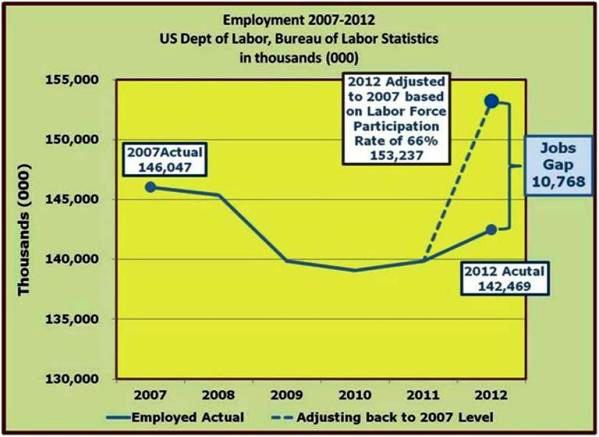
Contrary to some analysts who argue it is due primarily to the surge in the retirement of the large population cohort of baby boomers and not predominantly due to the lack of job opportunities resulting from an abysmally slow rate of economic growth, the data shows otherwise. These analysts casually disregard the collapse in the Labor Force Participation Rate (LFPR) as a consequence of demographic factors.
www.thebrennerbrief.com/2013/05/02/why-the-new-unemployment-number-cant-be-trusted/
May 2, 2013
"The labor participation rate fell slightly last month to 63.35, which is the lowest the U.S. labor participation rate has been since the 1970s. To be fair, part of this decline in workforce participation is due to discouraged workers, and another is certainly in part due to demographics. Austin Goolsbee and other Obama economic surrogates, love to point to the baby boomers as the cause for our shrinking labor force. However, if we actually examine the numbers, then it is clear that baby boomers cannot account for such a steep decline.
Since January 1, 2011, approximately 10,000 baby boomers turned 65 everyday, or roughly 300,000 every month. How many of them actually retire? According to Pew Research Center, it would not be very smart to tell the baby boomer generation that 65 is an age that is too old to work. A full 61% say that "old-age" does not even begin until around 72 years-old. Does this translate into increased labor participation? You bet. During the period from March of 2012 to March of 2013, the labor participation rate among baby boomers fell from 7.6% to 6.9% – that’s only a total of 93,000 people for the month of April. In total, 496, 000 people left the U.S. labor force in the month of April. Mr. Goolsbee can blame the baby boomer generation all he wants, but the fact is, many baby boomers are either choosing to work, or cannot afford not to work. Who are the other 403,000 people Mr. Goolsbee?"
But as we cited in earlier issues of this newsletter, despite the free fall of the LFPR and the employment ratio, the 55 + age groups have reflected the opposite pattern in its participation rate and employment ratio which have risen for this group. It is the younger population cohorts above 16 years of age that have been experiencing these drops in their LFPR and their employment ratio.
2012 Volume Issue 3
Economic Newsletter for the New Millennium
February 22, 2012
"With regard to funding pensions in both the private and public sector, keep your eyes on the Labor Force Participation Rate (LFPR); the baby-boomers will have to maintain much higher rates going forward:
- The current LFPR for 55 and over is around 40%; in 1995, the number was 30%
- The LFPR for 65+ is 18% and in 1995 it was 12%
- For 75+ it is 7.5%; 1995 it was around 4.5%
To paraphrase the fellow in the Dos Equis beer commercials:
Stay healthy my friends www.youtube.com/watch?v=U18VkI0uDxE
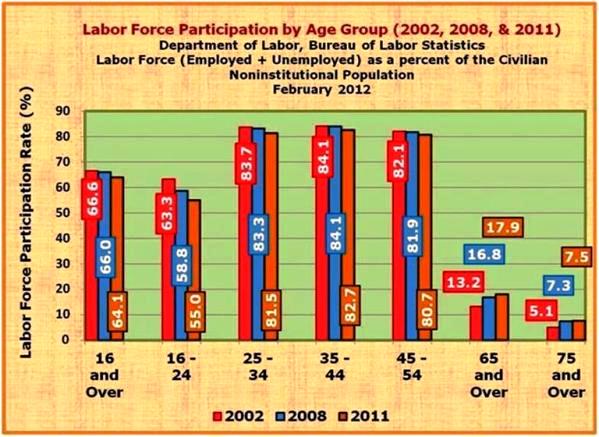
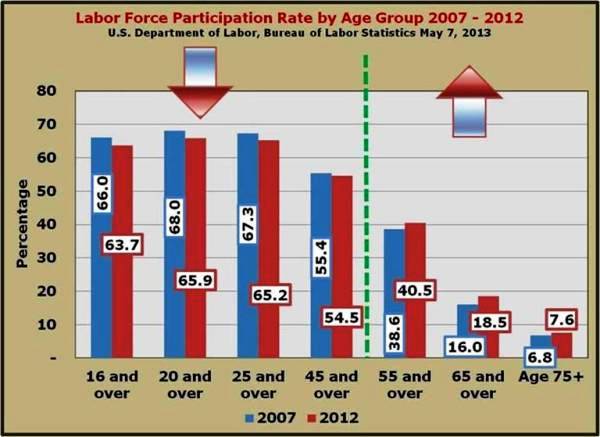
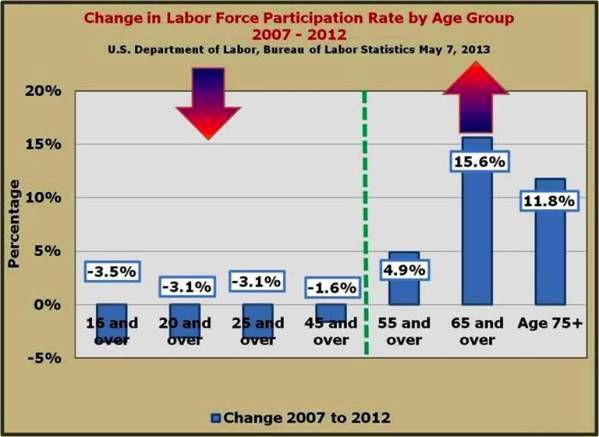
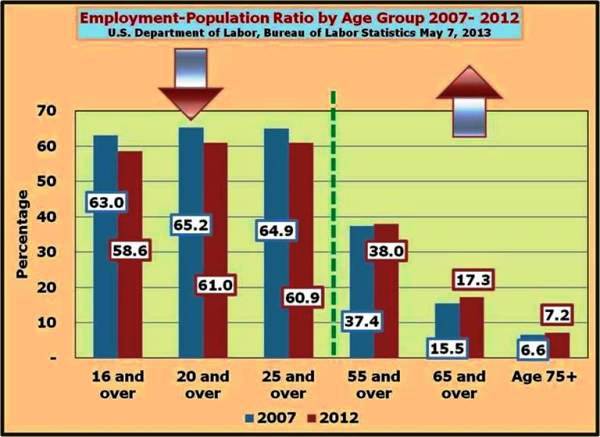
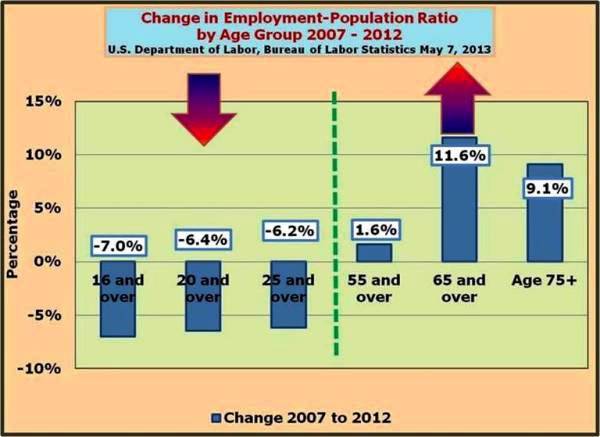
Theoretical welfare economics and the income distribution
Have any of the proponents of income redistribution proclaimed the criteria for an ideal income distribution (in the first place) and the resulting degree of inequality that would exist in that distribution? We have not heard it. All we hear is that the rich are too rich and the poor are too poor. They argue, tax the rich and reduce the burden of paying for government to the poor.
We can do much, much better in analyzing the problem. Unfortunately, too many economists give short shrift to the areas of economic theory that give us guidance in this area of public policy. The economics of income determination and theoretical welfare economics contain the economic analysis needed to examine the issue rationally in a fair and objective manner. Unfortunately, the battlefield is dominated by rambling economic ideologies rather the application of economic reasoning.
The goals to be achieved for an economy to reach optimality are efficiency and equity on a microeconomic level and high employment and a reasonable degree of price level stability at the macroeconomic level. Let’s consider each of these four conditions before we proceed to examine why an economy falls short of these goals of optimality in the area of the income distribution especially, or, as it is more frequently termed, why an economy violates the theoretical economic welfare conditions. Only then can economic policies impacting the income redistribution avoid significantly reducing the rate of economic growth and avoid what is currently occurring both here in the U.S. of A. and in the EU.
The Optimal Conditions of Theoretical Welfare Economics
Efficiency is achieved when the per capita average levels of production and income are at their maximum. The economy would be producing the most out of the scarce productive resources available and the given level of technological ability it possesses.
EQUITY is achieved when productive resources (conventionally categorized as labor, capital, entrepreneurship, and land) receive as their reward for participating in the transformation process of production, just enough to bring them into employment and keep them employed. They are earning their opportunity cost level of income, i.e. just enough to bid them away from their next best COMPETITVE alternative employment. This would be true for not only labor but for every category of productive resources.
HIGH EMPLOYMENT is the labor market condition that occurs when those markets are cleared. Neither labor nor the firms that employ them have any market power and the quantity supplied of labor equals the quantity demanded. The level of the total compensation rate is that which causes every labor market to be cleared or reach its equilibrium. There is neither a shortage nor a surplus of labor in any market.
A REASONABLE DEGREE OF PRICE LEVEL STABILITY occurs when all markets are perfectly competitive and in long term equilibrium. This implies that neither suppliers nor demanders in any market possess any market or price power. When productive resources experience increases in their physical productivity, their marginal revenue products (the demand for productive resources such as labor) will rise as their productivity increases, all else equal. This will increase their opportunity costs. As long as their nominal compensation rates rise equal to their physical productivity rates, there will tend to be NO upward pressure on firms’ costs and prices charged to buyers. To the extent that some of the physical productivity gains are not attributable to specific productive resources, unit costs will fall and competitive pressures will put downward pressure on the product prices. Hence, a very mild deflation rate would tend to occur.
Because the productive resource labor embodies differing amounts of human capital, their opportunity costs, including reservation prices if they are entrants into the production process, will differ. Equity and the attainment of commutative justice do not mean nor require equality!
Since all productive resources bear varying risks in the production process, the resulting inequality in the income distribution is a necessary one and is consistent with the attainment of equity and justice. Unequal incomes reflecting differing incomes due to such differences in risk is reflected in the risk-reward relationship.
Then you might ask, why the clamor over inequalities in the income distribution? Our free market capitalistic system is not perfect. The major reasons for the lack of perfection are: external costs and benefits requiring government intervention if internalization of these externalities is to occur; some markets are unable to prevent non-payers from enjoying the benefits of the goods or services produced in those markets (some economists would term these goods and services as being non-rival in consumption); some markets are termed as being natural monopolies or natural oligopolies and incapable of experiencing significant competition without being very inefficient given the technologies available.
Even the productive resource markets such as those for labor and capital, lack perfection in their operation. Legislation allowing labor to organize into cartels called unions, give the suppliers of the productive resource, labor, price power through unions controlling the labor supply. Labor unions are a cartel.
Legislation gives investment bankers the exclusive control of much of the movement of financial capital to finance the real capital investments of corporate firms. Other imperfections in markets occur as well, but you get the idea.
Some economists argue that the widespread occurrence of these imperfections in the markets renders the application of theoretical welfare economics meaningless. Nothing could be further from the truth. The execution and even handed application of properly written Anti-trust legislation in areas referred to as natural oligopolies such as the automotive and crude oil markets can minimize departures from the attainment of the economic welfare conditions explained above.
Effective regulation of natural monopolies such as public utilities, guided by these welfare goals, has the potential for reducing the departures from the attainment of such goals as efficiency and equity, if as George Stigler (early or ‘Chicago 1 School’ of thought ) argued and only if, ‘REGULATORY CAPTURE’ does NOT occur. In a large majority of cases, since both efficiency and equity cannot both be achieved concurrently, one of the two goals must be selected legislatively as the goal to be achieved by the regulatory mandate. Since private sector ownership is dominant in the U.S., equity is usually designated.
In the case of natural oligopolies, unnecessary concentration in such industries is critical if the welfare goals of efficiency and equity are to be as closely approximated as possible. In these cases, vigilant execution of the anti-trust laws is a necessity.
Such measures of concentration as the Hirschman-Herfindahl index and the three, four, five, and eight firm concentrations ratios can give objectivity to the determination of excessive concentration that leads to market or price power and excessive rewards to the productive resources involved. The older term economic rent has been frequently replaced with the term producer surplus. More specific terms reflecting such excess rewards resulting in an excessive degree of inequality in the income distribution are: surplus labor compensation, surplus or excess profits, and excessive management compensation.
In the U.S., enforcing anti-trust laws falls chiefly upon two agencies, the Anti-Trust Division of the U.S. Justice Department and the Federal Trade Commission (FTC). In recent years, their failures in this regard are far more common than their successes. The recartelization of the U.S. segment of the crude oil industry from 1993 through 2003 is one of the latest and one of their greatest failures. The only fortunate side effect of the resulting price gouging, was the acceleration of the fracking technology for natural gas, oil, and now apparently geothermal energy.
High Gas Prices – Recipe for Killing an Economic Recovery
March 27, 2012
www.econnewslettermar272012.com/
1990s MERGER MANIA higher prices today
Some of the arguments for consolidation included the desire to increase efficiencies and provide petroleum products at lower cost to the consumer...yeah, right!
- 1997 Ashland Oil combines most assets with Marathon Oil
- 1998 British Petroleum (BP) acquires Amoco
- 1998 Pennzoil merges with Quaker State Oil
- 1999 Exxon and Mobil join to form Exxon Mobil
- 2000 British Petroleum (BP) acquires ARCO (Atlantic Richfield)
- 2001 Chevron acquires Texaco to form Chevron Texaco
- 2002 Conoco merges with Phillips
- 2002 Royal Dutch Shell acquires Pennzoil-Quaker State
THE ECONOMICS OF CRUDE OIL PRICES AND THE IMPACT OF COMPETITION, OR THE LACK THEREOF
August 22, 2011
www.econnewsletteraug221011.com/
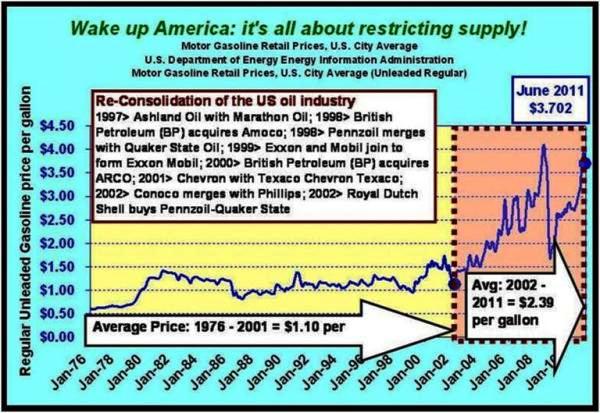
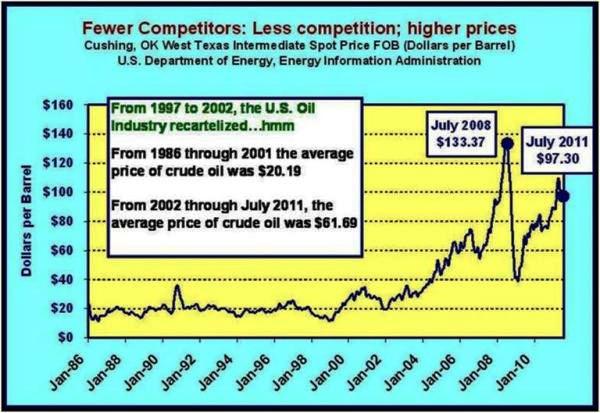
The attainment of the economic welfare goals is not a case of all or nothing. Violations or failures to achieve these goals are a question of degree. Picture a semi-circle of 180 degrees with full achievement on the right end of the semi-circle and complete failure on the left end. As markets become more competitive, the economy moves closer to full attainment of the optimal welfare conditions at both the microeconomic and the macroeconomic levels.
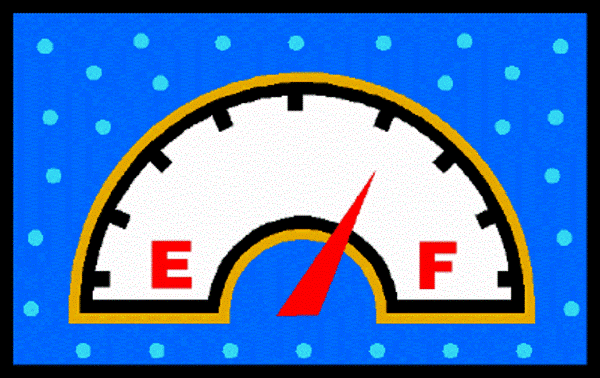
Better regulation of public utilities. stricter enforcement of the anti-trust laws, curtailing the power of unions including those of government employees, more rational patent and copyright legislation, certifications based on rational grounds and not primarily political lobbying, etc, etc. move the economy closer to the achievement of the theoretical economic welfare goals.
As competition in markets diminishes for whatever reason, the economy moves away from the attainment of the welfare goals. It is not a case of either, or. Monetary and fiscal stimulus decrease in potency as well and the dosage must be increased to the point where the side effects of such stimuli become as harmful, if not more harmful, than the problems they seek to address. Just look at the chaos within the EU and the growing fear of sovereign risk for the U.S. There is growing fear of a so-called ‘train wreck’ for Obamacare which is an attempt at income redistribution via the provision of health care rather than by the tax and transfer payment route.
Theoretically, what decreasing competition in markets causes is downward price rigidity. This is true in both the product markets for goods and services as well as the productive resource markets for labor, debt and equity capital, entrepreneurship, and land.
Price or market power is increased as the control over supply rises by firms and productive resources as competition deceases. The supply is managed to maximize profits and as well as the rewards to the other productive resources and not for the maximization of efficiency and the achievement of equity and justice. As result, on a microeconomic level, output tends to be less than required for the achievement of efficiency, and the income distribution becomes excessively unequal and violates equity.
On a macroeconomic level, prices will continue to rise as shortages occur, but are constrained NOT to fall or fall less than would have occurred in a more competitive environment, by a reduction in the supply of output or productive resources such as labor. Thus, output cuts to eliminate surpluses and their accompanying downward pressure on prices, replace price cuts. The result is that an inflationary bias arises. A second result of the increased downward price rigidity is that it tends to increase the frequency, severity and duration of recessionary episodes in the economy than would be the case if the markets in the economy were more competitive and firms and productive resources had less market or price power. In short, the downward price rigidity increases as competition decreases and the phenomenon of downward price rigidity decreases as competition in markets increases.
FREE MARKET CAPITALISM IN A DYNAMIC SETTING OF ADAPTING TO CHANGE
Like it or not, life is permeated with change. Markets must adapt to changes in consumer preferences, technological advances, the changing availability of resources, and so forth and so on. The successful firms will quickly adapt to such changes. The electronics industry is continually bringing out new and better products. Prices of new products are very high for a shot time but as competition follows, they prices of the new products fall and even though a better product results, it is usually cheaper than the old one that is replaced.
Resources must be shifted from one use to another. As new products and news ways of producing those products occur, the firm must adapt or wither away. Adapting to change is not without risk. It is difficult to move resources such as labor and capital. In these cases, rewards to productive resources involved in these changes must be increased to bring about the change. If competition follows the new products and new ways of producing them, the premiums for adapting to change will gradually move towards equitable levels. With ill-conceived patent laws, the movement toward equity levels of rewards will take longer. Thus, patent and copyright laws, though necessary for an acceptable flow of creativity and technological change, should not be overly protective. Excessively large firm’s domination of new markets should be scrutinized by the anti-trust authorities. The temporary increase in rewards to productive resources is a necessary even if the income distribution temporarily becomes more unequal. This is true for all productive resource rewards and not just profits.
Some of these concepts can be found in previous newsletters cited throughout this newsletter. Additional rigor and more thorough presentations will be found in the textbooks soon to be published by the editors of this newsletter. Look for information on these books in future newsletters.


